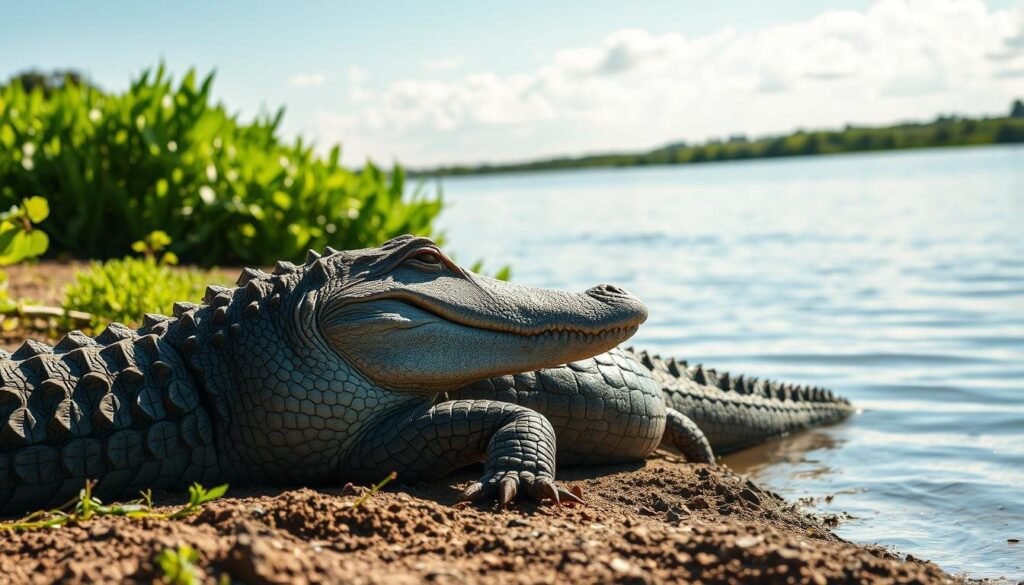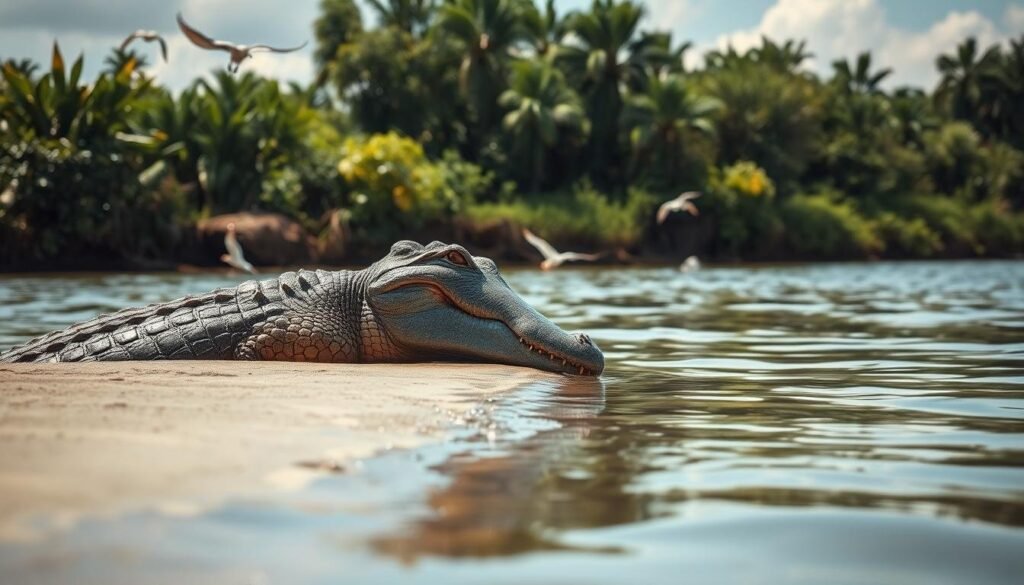Why Crocodiles Bask on Riverbanks During the Day? Have you ever wondered why crocodiles are often seen basking in the sun? This isn’t just a simple habit. It’s a complex behavior influenced by many factors.
The reasons for crocodile behavior are varied. They include saving energy, avoiding predators, and social interactions. Learning about these factors can give us a peek into the fascinating world of crocodiles and their riverbank basking habits.
As we dive into this topic, you’ll learn more about these fascinating creatures. You’ll see how their behavior is crucial in their natural habitat.
Contents
- 1 The Basking Behavior of Crocodiles
- 2 Why Do Crocodiles Bask on Riverbanks During Daytime?
- 3 Energy Conservation and Metabolic Benefits
- 4 Predator Avoidance and Safety Strategies
- 5 Social Dynamics and Communication
- 6 Species Variations and Environmental Adaptations
- 7 Conclusion: Why Crocodiles Bask on Riverbanks During the Day?
- 8 FAQ
- 8.1 Why do crocodiles bask on riverbanks during the day?
- 8.2 How does basking help crocodiles conserve energy?
- 8.3 What is the role of basking in predator avoidance for crocodiles?
- 8.4 How does basking behavior relate to the social dynamics of crocodiles?
- 8.5 Do different species of crocodiles exhibit variations in their basking behavior?
- 8.6 How do environmental changes impact the basking behavior of crocodiles?
- 8.7 Why is understanding the basking behavior of crocodiles important?
The Basking Behavior of Crocodiles
Crocodiles often lie on riverbanks, soaking up the sun. This is not just a casual act. It’s a key part of their reptile behavior with many benefits. [Why Crocodiles Bask on Riverbanks During the Day?]
Being ectothermic, crocodiles use the sun to control their body temperature. Basking during the day helps them stay healthy and saves energy. This daytime habit is crucial for their well-being.
- Thermoregulation: Helps in maintaining an optimal body temperature.
- Energy Conservation: Reduces the need for metabolic heat production.
- Ecological Adaptation: Allows crocodiles to be active during their preferred hunting times.
Learning about crocodiles’ basking behavior helps us understand their needs. It shows why we must protect their habitats.
Why Do Crocodiles Bask on Riverbanks During Daytime?
Have you ever seen crocodiles lying on riverbanks, soaking up the sun? They do this because they are ectothermic animals. This means they need outside heat to keep their body temperature right for their body’s needs.
By basking in the sun, crocodiles get the heat they need. This is a key part of their wildlife habits and daily life. [Why Crocodiles Bask on Riverbanks During the Day?]
- Regulating body temperature to optimize metabolic functions.
- Enhancing digestion and energy production.
- Possibly aiding in the regulation of their circadian rhythms.
Learning about crocodile behavior helps us understand how they adapt to their environment. Basking on riverbanks lets them save energy that would be used to keep their body warm.
Benefits of Basking
Basking has many good points for crocodiles:
| Benefit | Description | Impact on Crocodiles |
|---|---|---|
| Temperature Regulation | Absorbing heat from the sun | Optimizes metabolic processes |
| Energy Conservation | Reducing the need for internal heat generation | Conserves energy for other activities |
| Enhanced Digestion | Improved digestive efficiency | Better nutrient absorption |
Energy Conservation and Metabolic Benefits
Crocodiles basking in the sun on riverbanks is key to their survival. It helps them keep a stable body temperature. This is essential for their metabolic processes.
Basking saves crocodiles energy that would be used for foraging or moving. This is crucial, especially when food is hard to find. [Why Crocodiles Bask on Riverbanks During the Day?]
Keeping a stable body temperature boosts their digestion and overall health. Basking doesn’t just warm them up. It also helps them digest food better and keeps their body functions in check.
Metabolic Benefits of Basking
| Physiological Process | Benefit of Basking |
|---|---|
| Digestion | Enhanced digestive efficiency |
| Energy Conservation | Reduced energy expenditure on thermoregulation |
| Overall Physiology | Improved metabolic rate and bodily functions |
Learning about riverbank basking shows us how clever crocodiles are. They have evolved amazing strategies to survive and thrive in their habitats. [Why Crocodiles Bask on Riverbanks During the Day?]
Predator Avoidance and Safety Strategies
Crocodiles basking on riverbanks during the day do more than just enjoy the sun. They use this time to avoid predators. By staying in open areas, they can see threats from far away. This gives them an early warning.
While basking, crocodiles stay alert and ready to jump into the water at the first sign of danger. Their quick response is key to their survival. [Why Crocodiles Bask on Riverbanks During the Day?]
So, how does this help them avoid predators? The open riverbanks let crocodiles see movements and spot predators easily. This clear view is vital for their safety, allowing them to act fast when needed.
Crocodiles also use their senses to detect danger. They can feel water vibrations from approaching predators. This helps them avoid attacks even better.
Key Benefits of Basking for Predator Avoidance
- Enhanced visibility to spot predators from a distance
- Quick response to threats by sliding into the water
- Utilization of multiple senses to detect danger
By basking during the day, crocodiles lower their risk of being attacked. This shows their adaptability and survival skills in their natural habitats. [Why Crocodiles Bask on Riverbanks During the Day?]
Social Dynamics and Communication
When you see crocodiles on riverbanks, it’s more than just a survival act. It’s a complex social behavior. They gather to communicate, showing off and making sounds. This helps them keep their social order and find mates.
Their social life is rich and varied. Crocodiles use body language and sounds to share important info. They talk about who’s in charge, who’s interested in who, and who might be a danger. This keeps their group stable.
Learning about reptile behavior, especially crocodiles, shows us how they live together. Their ability to talk to each other while basking shows how complex their social lives are.
In short, crocodiles basking is not just about staying alive. It’s also about their social lives. It shapes how they act and interact with each other.
Species Variations and Environmental Adaptations
Exploring different crocodile species shows us how they bask in various ways. Each species has unique adaptations to its environment. This affects how they bask on riverbanks.
The Nile crocodile basks often in warm temperatures. The Siamese crocodile, however, basks less and prefers shaded areas. These differences show the intricate link between crocodiles and their habitats.
Temperature Shifts and Behavioral Responses
Crocodiles are ectothermic, meaning their body temperature depends on the environment. They adjust their basking based on temperature. In cold places, they bask more to warm up. In warm places, they bask less to cool down.
Temperature changes greatly affect crocodile behavior. It influences their activity and energy use. By changing their basking, crocodiles keep their body temperature right, helping them survive in different places.
| Species | Basking Frequency | Preferred Temperature Range |
|---|---|---|
| Nile Crocodile | High | 25-30°C |
| Siamese Crocodile | Low | 20-25°C |
| Saltwater Crocodile | Moderate | 22-28°C |
Habitat Loss and Adaptation
Habitat loss and environmental changes are big challenges for crocodiles. They must change their basking habits. When habitats change, crocodiles need to find new places to bask.

Crocodiles might change their activity or look for new basking spots. Knowing how they adapt helps us protect them and their homes. [Why Crocodiles Bask on Riverbanks During the Day?]
By looking at how different crocodile species bask and adapt, we learn a lot. It shows us the importance of keeping natural habitats safe.
Conclusion: Why Crocodiles Bask on Riverbanks During the Day?
Crocodiles’ basking on riverbanks is more than just a simple act. It’s a key survival strategy. They use it to save energy, stay safe from predators, and connect with others.
This crocodile behavior shows how well they adapt to their surroundings. It helps them thrive in different environments. Learning about this behavior gives us a peek into their biology and ecology.
The evolutionary importance of basking is clear. It helps crocodiles survive and thrive. As we explore nature, seeing how species interact with their environments enriches our understanding of ecosystems.
See Also: Why Do Sloths Move So Slowly Through Trees?
FAQ
Why do crocodiles bask on riverbanks during the day?
Crocodiles bask on riverbanks to keep their body temperature stable. It helps them save energy and stay safe from predators. They also use it to interact with each other.
How does basking help crocodiles conserve energy?
Basking lets crocodiles save energy that would be used for hunting or moving. It also helps their metabolism.
What is the role of basking in predator avoidance for crocodiles?
Basking helps crocodiles spot dangers from far away. They can quickly jump into the water if needed.
Basking is key in crocodile social life. It lets them communicate through body language and sounds. [Why Crocodiles Bask on Riverbanks During the Day?]
Do different species of crocodiles exhibit variations in their basking behavior?
Yes, different crocodile species have unique basking habits. This is due to their environment, like temperature.
How do environmental changes impact the basking behavior of crocodiles?
Changes in their habitat can affect how crocodiles bask. They must adjust to new conditions. [Why Crocodiles Bask on Riverbanks During the Day?]
Why is understanding the basking behavior of crocodiles important?
Knowing how crocodiles bask helps us understand their biology and how they adapt. It’s crucial for conservation.

Zyair Larson, based in Denver, Colorado, has over 12 years of experience studying animal behavior. He has worked with the World Wildlife Fund (WWF) and National Geographic, researching wildlife and sharing insights on animal habits globally.

